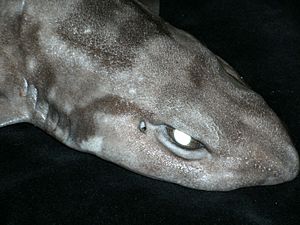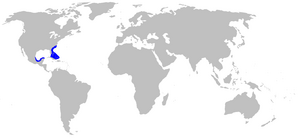Blotched catshark facts for kids
Quick facts for kids Blotched catshark |
|
|---|---|
 |
|
| Conservation status | |
| Scientific classification | |
| Genus: |
Scyliorhinus
|
| Species: |
meadi
|
 |
|
| Range of the blotched catshark | |
The blotched catshark (scientific name: Scyliorhinus meadi) is a type of catshark that lives in the deep waters of the western central Atlantic Ocean. It's a bit of a mystery because scientists haven't seen many of them! This shark makes its home among deep-sea coral reefs, usually between 329 and 548 meters (about 1,080 to 1,800 feet) deep.
You can spot a blotched catshark by its wide body and head. It also has dark, saddle-like markings on its back. A cool fact about these sharks is that they have tiny spots that glow yellow when a blue light shines on them! This is called fluorescence. The biggest blotched catshark found so far was about 49 centimeters (19 inches) long, but it was still a young one. Scientists believe these sharks lay eggs, just like other catsharks. Don't worry, they are not dangerous to people and aren't caught for fishing.
Contents
Discovering the Blotched Catshark
The blotched catshark was first officially described in 1966. An American scientist named Stewart Springer, who studies fish (ichthyologist), gave it its scientific name. He based his description on a young male shark that was 25 centimeters (about 10 inches) long. This shark was found off the coast of Cape Canaveral, Florida.
Stewart Springer named the shark after Giles W. Mead, who first showed him the specimen. For a while, from 1970 to 1979, some scientists thought this shark was just a type of chain catshark (S. retifer). But now, it's known as its own unique species.
Where Blotched Catsharks Live
The blotched catshark has been found in several places in the Atlantic Ocean. These include areas from North Carolina down to the Santaren Channel, which is between Florida, the Bahamas, and Cuba. They've also been seen in the Cayman Trench near northern Jamaica and in the Gulf of Mexico, north of the Yucatan Peninsula.
This shark is quite rare. It lives on the upper part of the continental slope, which is the sloping edge of the continent that goes down into the deep ocean. They prefer depths between 329 and 548 meters (about 1,080 to 1,800 feet). Blotched catsharks are bottom-dwelling creatures, meaning they live on or near the seafloor. They are often found among deepwater coral banks, especially those made of a type of coral called Lophelia pertusa.
What Blotched Catsharks Look Like
So far, all the blotched catsharks that scientists have found have been young ones. The largest male was 49 centimeters (19 inches) long, and the largest female was 43 centimeters (17 inches) long. This shark has a wide, strong head and body. Its body gets much narrower towards its tail.
The small skin flaps next to its nostrils don't reach its mouth. When its mouth is closed, you can still see the teeth in its upper jaw. There are also small grooves at the corners of its lower jaw.
Fins and Skin
The first dorsal fin (the fin on its back) is located above its pelvic fins (the fins on its belly). The second dorsal fin is above its anal fin (the fin near its tail). The caudal fin (tail fin) is almost flat, like a straight line. It has a small lower part that isn't very clear and a noticeable notch near the tip of the upper part.
The shark's skin feels quite smooth. This is because its dermal denticles (tiny, tooth-like scales that cover a shark's skin) are small and flat. The blotched catshark has a dark background color with 7 to 8 darker, saddle-like markings across its back. As mentioned before, it also has small spots that glow yellow under a blue light, just like its relative, the chain catshark.
What Blotched Catsharks Eat and How They Live
Blotched catsharks eat cephalopods (like squid and octopuses), shrimp, and even surprisingly large bony fishes.
Scientists believe that blotched catsharks lay eggs that are protected inside tough cases. This is how other members of their shark family reproduce. However, no one has actually seen these egg cases yet. Since the sharks found so far have been young, it suggests that adult blotched catsharks might be quite large!
Blotched Catsharks and People
The blotched catshark is not harmful to humans. It's also very rarely caught by fisheries (fishing boats). Because of this, it doesn't have much importance in the economy. The International Union for Conservation of Nature (IUCN) has listed the blotched catshark as "Least Concern." This means that its population is currently stable and not at risk of disappearing.
See also
 In Spanish: Scyliorhinus meadi para niños
In Spanish: Scyliorhinus meadi para niños


